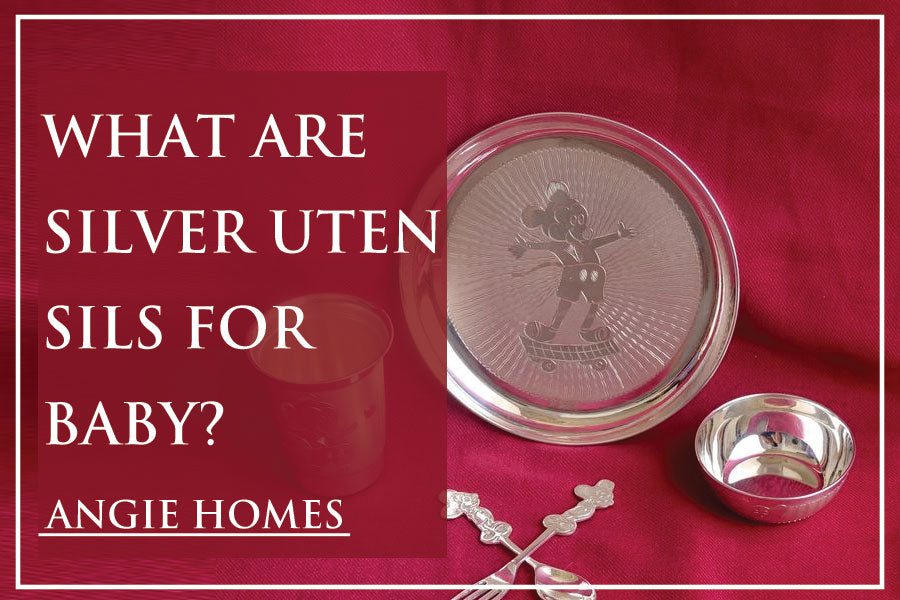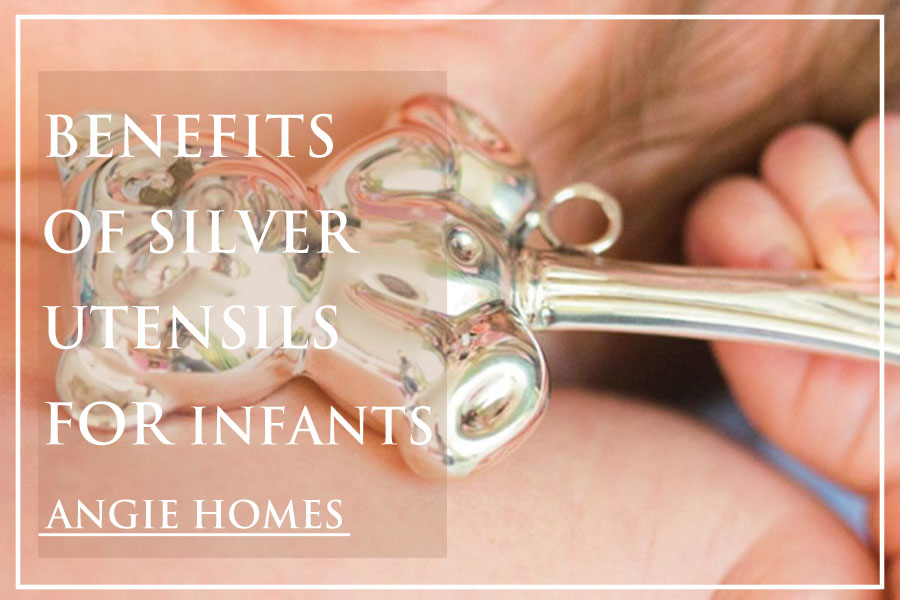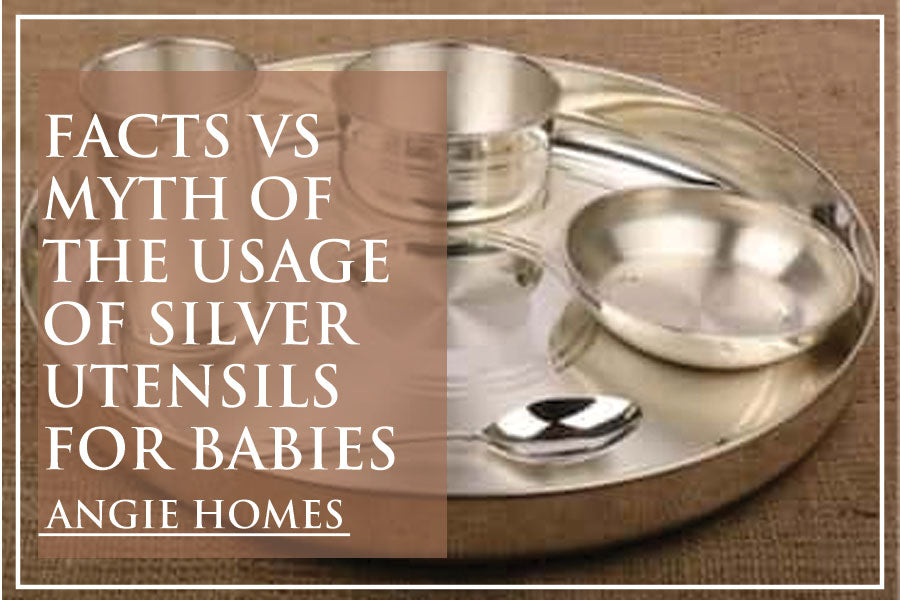The desire for utensils for babies attracts massive attention from parents, and silverware regularly sparks debates fueled by myths and misconceptions. In this exploration of "Silver Utensils for Babies: Myths vs Facts," we delve into the not-unusual beliefs surrounding the usage of silver for babies. While some assert that silver brings precise success, others question its safety. This discussion seeks to dispel myths and offer evidence-based insights into the advantages of Silver Utensils for Babies. Separating truth from fiction is essential for knowledgeable parenting choices as we navigate the practicalities, safety, and developmental components of introducing silverware to our infants.
What are Silver Utensils for Baby?

Silver Utensils for Babies encompass a range of specialized feeding equipment meticulously designed to cater to the particular desires of babies embarking on their journey to strong ingredients. Crafted from silver substances, those utensils prioritize capability and the delicate nature of a child's gums and rising enamel. Soft-tip spoons with gentle, rubberized ends provide a secure and cushy experience during the important transition to self-feeding. Ergonomic handles are tailored to shape small hands, promoting a natural grip and facilitating the improvement of great motor skills as babies learn how to manipulate utensils independently.
Beyond their realistic design, the selection of silver for infant utensils extends to the inherent antimicrobial properties of the metallic. Silver's ability to inhibit the increase of microorganisms contributes to a hygienic feeding environment, assuring parents of a reduced threat of contamination. This aligns with the tradition of supplying silver utensils to infants as greater than simply functional equipment; they represent excellent success and prosperity, growing a connection between cultural ideals and sensible issues for a child's well-being.
Types of Silver Utensils for Baby

The 7 Types of Silver Utensils for Baby:
-
Soft-Tip Spoons:
Soft-tip spoons are a staple in child silverware collections, designed to cater to the delicate nature of a child's gums and emerging teeth. Characterized via a mild, rubberized tip, these spoons offer a secure and cushy revel in the course of the transition to stable ingredients. The smooth fabric minimizes the hazard of unintentional accidents and encourages unbiased feeding. The thoughtful layout guarantees the infant can explore diverse textures without pain, fostering a fantastic affiliation with self-feeding.
-
Ergonomic Handle Utensils:
Silver Utensils for Babies with ergonomic handles are crafted to be in shape with ease in a child's small arms. The design promotes a natural grip, permitting the baby to hold and manipulate the utensils conveniently. The ergonomic handles play a vital function in the improvement of high-quality motor competencies as babies discover ways to coordinate their hand movements throughout self-feeding. These utensils often function in a layout that is both person-friendly for the infant and supportive of their rising motor abilities, making mealtime a more fun and developmental level.
-
Temperature-Sensitive Utensils:
Temperature-touchy silverware is a sensible desire for parents involved in serving meals at the best temperature for their child. These utensils regularly function as shade-changing indicators or materials that react to temperature variations. This provides a visible cue to alert caregivers if the meals are just too warm for the infant, minimizing the hazard of burns and ensuring a more secure dining experience. Temperature-touchy utensils exemplify the integration of safety functions into child silverware, improving the general functionality of those gear.
-
Divided Plates and Bowls:
While now not traditional utensils, divided plates and bowls are imperative additives to a toddler's dining set. These items are designed to facilitate portioning and provide booths for one-of-a-kind meal kinds. Divided plates and bowls are often geared up with suction bases to prevent unintended spills, making mealtime less messy. This form of silverware accent supports the introduction of various textures and flavours to the toddler's food regimen, encouraging a various and balanced ingesting revel.
-
Training Forks:
As Silver Utensils for Babies progress in their self-feeding adventure, schooling forks become valuable additions to their utensil set. These forks are mainly designed for children, presenting rounded and blunted prongs to lessen the hazard of accidents. Training forks resource within the development of dexterity and coordination required for piercing and lifting food. The advent of forks progressively teaches the baby greater advanced utensil competencies, placing the degree for independent eating conduct as they develop.
-
Self-Feeding Utensils:
Self-feeding utensils are tailor-made to empower infants as they gain independence in ingesting. These utensils frequently have shorter handles and broader, shallow bowls, allowing babies to scoop and draw close food extra easily. The design helps the development of the pincer grasp and hand-eye coordination. Self-feeding utensils inspire the baby to take a lively role in mealtime, enhancing their autonomy and confidence. These utensils mark a big step in the toddler's adventure towards learning using adult utensils.
-
Travel-Friendly Sets:
For on-the-move dads and moms, tour-pleasant silverware units offer convenience and portability. These units commonly include a selection of baby utensils and can include a compact wearing case for easy storage and shipping. The utensils in these sets often mirror the layout capabilities of those used at home, ensuring a constant feeding revel for the child. Travel-pleasant units cater to the practical needs of dads and moms who need to preserve acquainted feeding habits, whether at home or away.
Benefits of Silver Utensils for Infants

There are five Benefits of Silver Utensils for infants:
-
Antimicrobial Properties for a Hygienic Feeding Environment:
One of the standout benefits of using Silver Utensils for Babies lies in their natural antimicrobial residences. Silver has been identified for hundreds of years for its potential to inhibit the boom of microorganisms, viruses, and fungi. This makes it a first-rate choice for utensils that come into direct touch with a baby's food and mouth. The antimicrobial residences of silver play a vital position in minimizing the danger of bacterial infection at some stage in feeding, imparting an additional layer of safety past ordinary cleaning and sterilization. Caregivers can have confidence that silver utensils make contributions to a hygienic feeding environment, assisting the general health and well-being of the toddler.
-
Developmental Support through Thoughtful Design:
Silver utensils for toddlers are thoughtfully designed to align with the developmental stages of toddlers. Soft-tip spoons with gentle, rubberized ends are crafted to prioritize the delicate nature of a child's gums and rising enamel all through the weaning method. Ergonomic handles are tailored to match small arms without difficulty, promoting a natural grip and assisting in the development of nice motor abilities. As babies progress to self-feeding, education forks and self-feeding utensils guide the refinement of dexterity and coordination. The design of silver utensils is going beyond capability; it actively contributes to the baby's developmental milestones, making mealtime an enriching and developmental level.
-
Enhanced Sensory Experiences and Palate Development:
Introducing silver utensils to babies enhances their sensory stories in the course of meals. The varied textures and temperatures encountered while using these utensils contribute to sensory stimulation. Soft-tip spoons, for instance, permit babies to discover specific food textures lightly. This sensory engagement helps improve the toddler's palate, fostering an early appreciation for a wide range of meals. By incorporating silver utensils into the feeding routine, caregivers can contribute to the holistic sensory improvement of the child, laying the muse for an effective relationship with food.
-
Cultural Symbolism and Meaningful Tradition:
The use of silver utensils for toddlers is regularly steeped in cultural symbolism and lifestyle. Silver is taken into consideration as a symbol of proper success and prosperity in many cultures. Presenting a silver spoon to a baby is a gesture laden with means representing a want for a fortunate and wholesome existence. This connection between silver utensils and cultural traditions adds a significant and symbolic measurement to the feeding experience. Using silver utensils will become more than a practical preference; it turns into a cherished thing of an infant's upbringing, connecting them to cultural roots and a circle of relatives traditions.
-
Durability and Longevity for Practical Investment:
Silver utensils are famous for their durability and sturdiness. Unlike some other substances, silver is proof against corrosion and tarnish, making sure that the utensils remain in good condition over time. This sturdiness is especially useful for baby utensils, which go through frequent use, cleaning, and sterilization. Investing in silver utensils for a child can show to be a smart desire, as they're in all likelihood to face up to the trials of everyday feeding routines and might potentially be handed down as heirlooms. The toughness of silver utensils provides a sensible dimension to their attraction, making them a dependable and enduring choice for caregivers looking for both capability and longevity in infant feeding tools.
Facts vs Myth of the Usage of Silver Utensils for Babies

There are many Facts vs Myth about using Silver Utensils for Babies :
Facts: The Hygienic Reality of Silver Utensils for Babies
Contrary to the parable that silver utensils are merely a culture, scientific proof supports the hygienic blessings of using silver for babies. Silver possesses inherent antimicrobial homes, inhibiting the boom of bacteria. This makes silver utensils an awesome choice for retaining a smooth feeding environment, decreasing the risk of bacterial infection for the duration of mealtime. The antimicrobial homes make contributions to the overall well-being of the child, aligning with the sensible need for hygiene in infant care.
Myth: Silver Utensils are Purely Superstitious
A common misconception surrounding silver utensils is that their use is rooted totally in superstition. While silver is certainly rich in cultural symbolism, dismissing it as, in simple terms, superstitious overlooks the realistic advantages it gives. Silver's antimicrobial properties, developmental support, and durability go beyond superstitions, making it a precious choice for caregivers looking for each tradition and capability in toddler utensils.
Facts: Developmental Benefits of Silver Utensils
The considerate layout of silver utensils aligns with the developmental needs of babies. Soft-tip spoons with mild, rubberized ends prioritize the sensitive nature of a child's gums, at the same time as ergonomic handles resource within the improvement of exceptional motor abilities. As toddlers develop to self-feed, education forks aid the refinement of dexterity and coordination. These layout features contribute to the child's developmental milestones, making using silver utensils more than a cultural practice; it actively enhances the toddler's growth and talents.
Myth: Silver Utensils are Merely Aesthetic
Some may additionally perceive the usage of silver utensils as simply aesthetic or ornamental. However, the aesthetic attraction of silver utensils is going hand-in-hand with their sensible benefits. The clean and non-porous floor of silver makes it easy to smooth, ensuring a safe and hygienic feeding revel. The aesthetic charm of silver utensils enhances their capability, growing a harmonious combo of beauty and practicality within the child's feeding routine.
Conclusion
In conclusion, using silver utensils for infants, frequently surrounded by the aid of cultural symbolism and conventional practices, is rooted in significant ideals and supported with the aid of practical advantages. While offering a silver spoon to a baby symbolizes proper success and prosperity, the inherent antimicrobial homes of silver contribute to a hygienic feeding environment. Separating myths from statistics, it's obtrusive that the choice of silverware is going past superstitions, emphasizing the significance of tradition, practicality, and the iconic desire for a healthful and lucky existence. As mother and father navigate child care, information on the importance of silver utensils offers a balanced perspective for informed picks.
Related Posts:
A Comprehensive Guide to Kids Silverware, Benefits, and Top Picks in India
An Ultimate Guide on Silverware, Its Types, Benefits, and Timeless Charm
Benefits Of Using Silver Bowls And Spoons To Feed A Baby
FAQ's
Q. What is the significance of giving a silver spoon to an infant?
Ans: Presenting a silver spoon to a toddler holds symbolic significance throughout numerous cultures. It is often visible as a gesture of accurate good fortune, prosperity, and the want for a fortunate life. The silver material is chosen for its antimicrobial properties, contributing to a hygienic feeding environment, whilst the present itself is an undying keepsake symbolizing a rich and wholesome future.
Q. Is silver the correct choice for infants?
Ans: Silver is frequently taken into consideration as a symbol of good fortune for toddlers. Beyond cultural beliefs, the selection of silver utensils is realistic, as silver possesses inherent antimicrobial houses, selling an easy and secure feeding environment. While the best success thing is subjective, the usage of silver for babies aligns with both the way of life and practicality.
